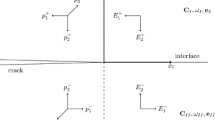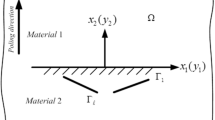Abstract
An interface crack with an artificial contact zone at the right-hand side crack tip between two dissimilar finite-sized piezoelectric materials is considered under remote mixed-mode loading. To find the singular electromechanical field at the crack tip, an asymptotic solution is derived in connection with the conventional finite element method. For mechanical loads, the stress intensity factors at the singular points are obtained. As a particular case of this solution, the contact zone model (in Comninou’s sense) is derived. A simple transcendental equation and an asymptotic formula for the determination of the real contact zone length are derived. The dependencies of the contact zone lengths on external load coefficients are illustrated in graphical form. For a particular case of a short crack with respect to the dimensions of the bimaterial compound, the numerical results are compared to the exact analytical solutions, obtained for a piezoelectric bimaterial plane with an interface crack.
Similar content being viewed by others
References
ABAQUS/Standard: Version 6.1 Karlsson & Sorensen Inc., Hibbith (2000)
Beom H.G. and Atluri S.N. (1996). Near-tip fields and intensity factors for interfacial cracks in dissimilar anisotropic piezoelectric media. Int. J. Fract. 75: 163–183
Comninou M. (1977). The interface crack. J. Appl. Mech. Trans. ASME 44: 631–636
Dundurs J. and Gautesen A.K. (1988). An opportunistic analysis of the interface crack. Int. J. Fract. 36: 151–159
Gao C.F. and Wang M.Z. (2000). Collinear permeable cracks between dissimilar piezoelectric materials. Int. J. Solids Struct. 37: 4949–4967
Govorukha V.B. and Loboda V.V. (2000). Contact zone models for an interface crack in a piezoelectric material. Acta Mech. 140: 233–246
Govorukha V.B., Munz D. and Kamlah M. (2000). On the singular integral equations approach to the interface crack problem for piezoelectric materials. Arch Mech. 52: 247–273
Govorukha V. and Kamlah M. (2004). Asymptotic fields in the finite element analysis of electrically permeable interface cracks in piezoelectric bimaterials. Arch. Appl. Mech. 74: 92–101
Gruebner O., Kamlah M. and Munz D. (2003). Finite element analysis of cracks in piezoelectric materials taking into account the permittivity of crack medium. Eng. Fract. Mech. 70: 1399–1413
Herrmann K.P. and Loboda V.V. (2000). Fracture-mechanical assessment of electrically permeable interface cracks in piezoelectric bimaterials by consideration of various contact zone models. Arch. Appl. Mech. 70: 127–143
Herrmann K.P., Loboda V.V. and Govorukha V.B. (2001). On contact zone models for an electrically impermeable interface crack in a piezoelectric bimaterial. Int. J. Fract. 111: 203–227
Kuna M. (1998). Finite element analyses of crack problems in piezoelectric structures. Comput. Mater. Sci. 13: 67–80
Kuna M. (2006). Finite element analyses of cracks in piezoelectric structures—a survey. Arch. Appl. Mech. 76: 725–745
Kuo C.M. and Barnett D.M. (1991). Stress singularities of interfacial cracks in bounded piezoelectric half-spaces. In: Wu, J.J., Ting, T.C.T. and Barnet, D.M. (eds) Modern theory of anisotropic elasticity and applications, pp 33–50. SIAM Proc. Series, Philadelphia
Ma L.F. and Chen Y.H. (2001). Weight functions for interface cracks in dissimilar anisotropic piezoelectric materials. Int. J. Fract. 110: 263–279
Pak Y.E. (1992). Linear electro-elastic fracture mechanics of piezoelectric materials. Int. J. Fract. 54: 79–100
Park S.B. and Sun C.T. (1995). Effect of electric field on fracture of piezoelectric ceramics. Int. J. Fract. 70: 203–216
Parton V.Z. (1976). Fracture mechanics of piezoelectric materials. Acta Astronaut. 3: 671–683
Qin Q.H. and Yu S.W. (1997). An arbitrarily-oriented plane crack terminating at the interface between dissimilar piezoelectric materials. Int. J. Solids Struct. 34: 581–590
Qin Q.H. and Mai Y.W. (1999). A closed crack tip model for interface cracks in thermopiezoelectric materials. Int. J. Solids Struct. 36: 2463–2479
Scherzer M. and Kuna M. (2004). Combined analytical and numerical solution of 2D interface corner configurations between dissimilar piezoelectric material. Int. J. Fract. 127: 61–99
Suo Z., Kuo C.M., Barnet D.M. and Willis J.R. (1992). Fracture mechanics for piezoelectric ceramics. J. Mech. Phys. Solids 40: 739–765
Ting T.C.T. (1986). Explicit solution and invariance of the singularities at an interface crack in anisotropic composites. Int. J. Solids Struct. 22: 965–983
Williams M.L. (1959). The stresses around a fault or crack in dissimilar media. Bull. Seismol. Soc. Am. 49: 199–204
Wu C.C., Sze K.Y. and Huang Y.Q. (2001). Numerical solutions on fracture of piezoelectric materials by hybrid element. Int. J. Solids Struct. 38: 4315–4329
Author information
Authors and Affiliations
Corresponding author
Rights and permissions
About this article
Cite this article
Govorukha, V., Kamlah, M. An analytically-numerical approach for the analysis of an interface crack with a contact zone in a piezoelectric bimaterial compound. Arch Appl Mech 78, 575–586 (2008). https://doi.org/10.1007/s00419-007-0179-0
Received:
Accepted:
Published:
Issue Date:
DOI: https://doi.org/10.1007/s00419-007-0179-0




